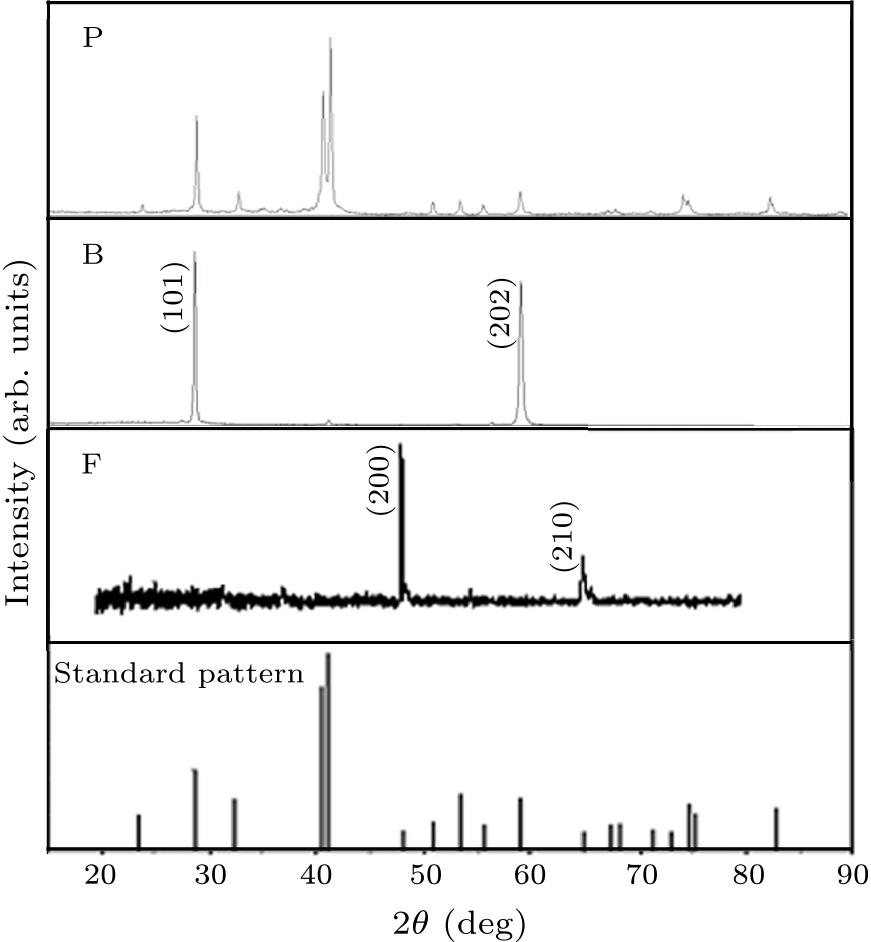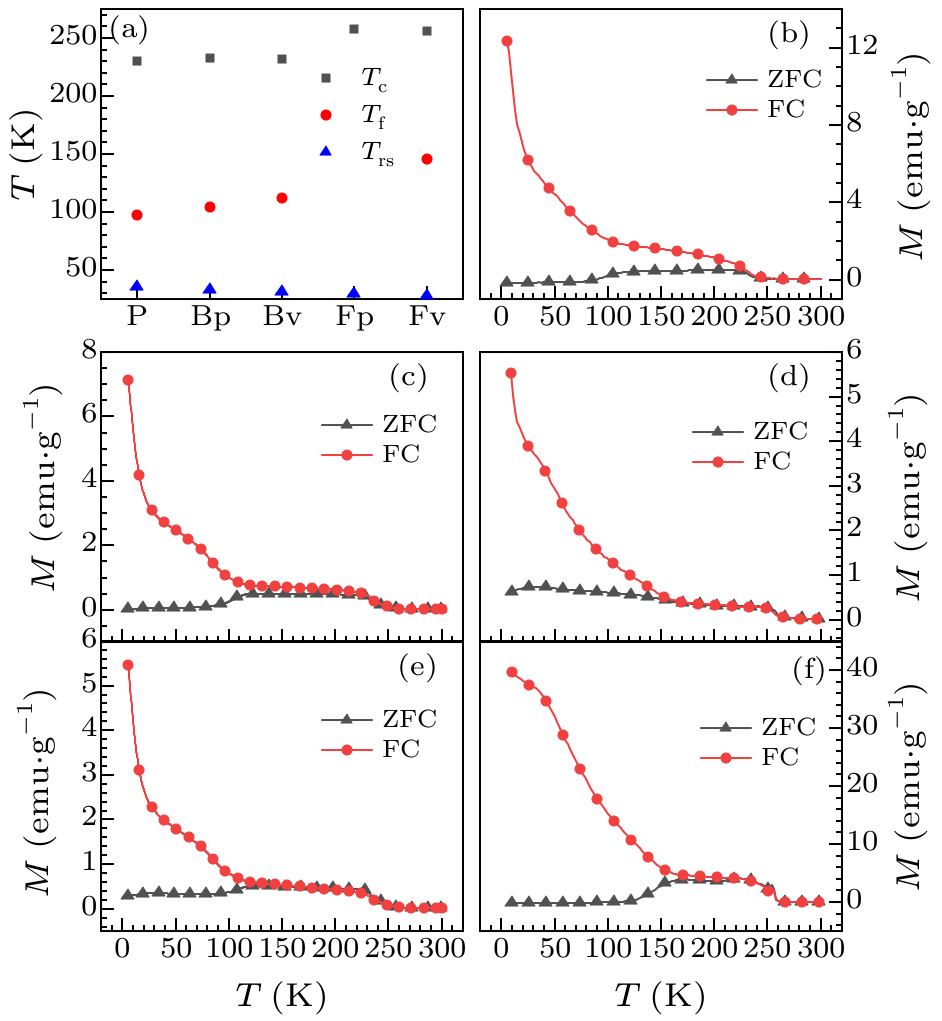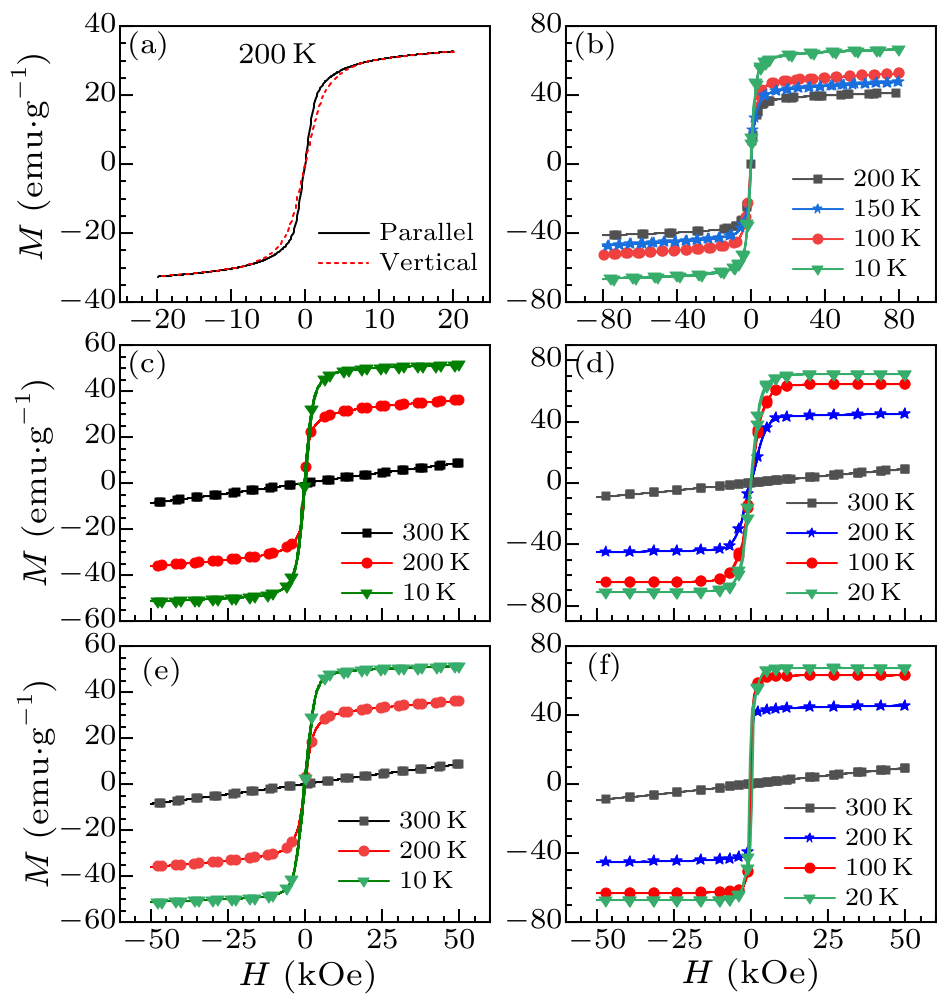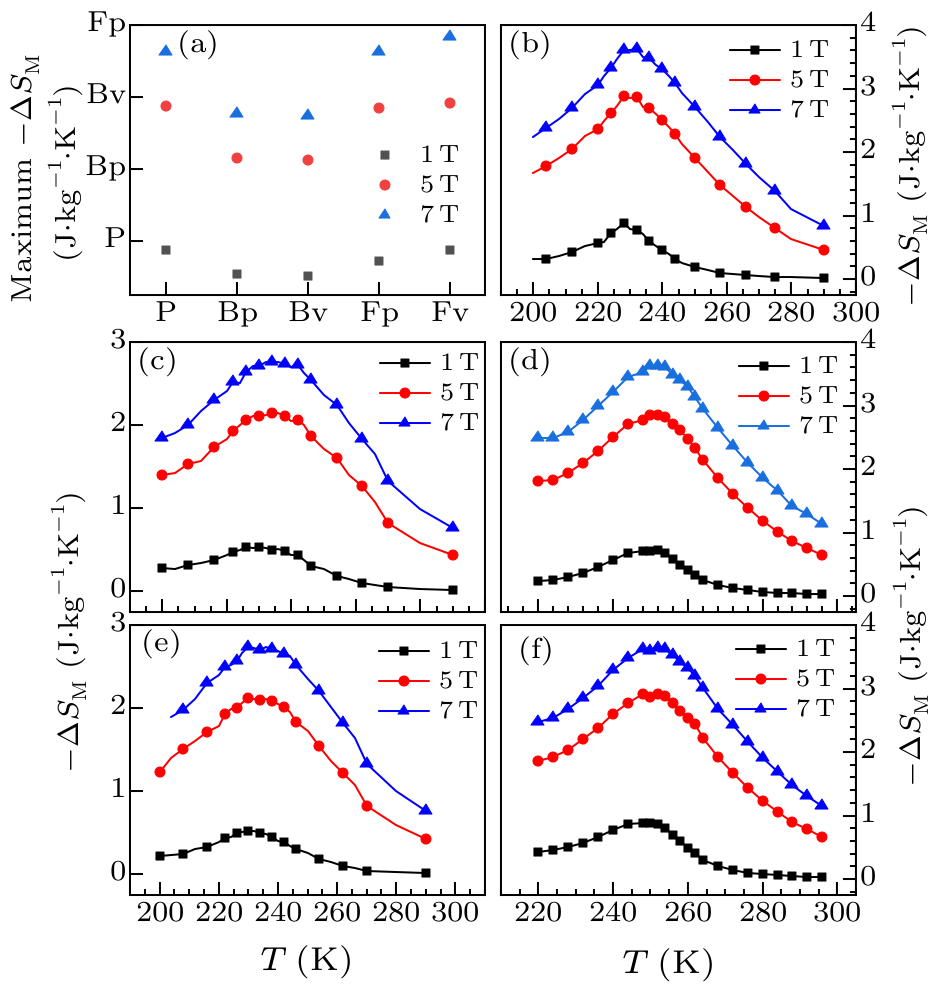
Fig. 1. X-ray diffraction patterns of P, B and F samples and of a standard sample.

Fig. 2. (a) Magnetic transition temperature for different samples. Here $T_{\rm C}$ is the Curie temperature, $T_{\rm f}$ is the freezing temperature, and $T_{\rm rs}$ is the spin-reorientation transition temperature. (b)–(f) Thermomagnetic curves for different samples under an applied magnetic field of 50 Oe under ZFC and FC conditions. Panels (b)–(f) correspond to samples P, Bp, Fp, Bv and Fv, respectively.
| $T_{\rm c}$ (K) | $T_{\rm f}$ (K) | $T_{\rm rs}$ (K) | |
|---|---|---|---|
| P | 230 | 97 | 35 |
| Bp | 233 | 104 | 33 |
| Bv | 232 | 112 | 31 |
| Fp | 258 | 29 | |
| Fv | 256 | 146 | 28 |

Fig. 3. (a) The $M$–$H$ loops of Bp and Bv at 200 K with an applied magnetic field up to 2 T (Bv is harder to saturate than Bp). (b)–(f) The $M$–$H$ loops of different samples at different temperatures. Panels (b)–(f) correspond to samples P, Bp, Fp, Bv and Fv, respectively.

Fig. 4. (a) Maximum $-\Delta S_{\rm M}$ for different samples with different applied magnetic fields. (b)–(f) Temperature dependence of magnetic entropy changes for different samples. Panels (b)–(f) correspond to samples P, Bp, Fp, Bv and Fv, respectively.
| Maximum $-\Delta S_{\rm M}$ (J$\cdot$kg$^{-1}\cdot$K$^{-1}$) | RCP (J$\cdot$kg$^{-1}$) | ||||
|---|---|---|---|---|---|
| $\Delta H=1$ T | $\Delta H=5$ T | $\Delta H=7$ T | $\Delta H=$5 T | $\Delta H=7$ T | |
| P | 0.88 | 2.88 | 3.62 | 201 | 296 |
| Bp | 0.54 | 2.15 | 2.76 | 185 | 251 |
| Bv | 0.52 | 2.12 | 2.74 | 182 | 260 |
| Fp | 0.72 | 2.85 | 3.62 | 174 | 286 |
| Fv | 0.88 | 2.91 | 3.64 | 212 | 302 |
| [1] | Groot R A D, Mueller F M, Engen P G V and Buschow K H J 1983 Phys. Rev. Lett. 50 2024 | New Class of Materials: Half-Metallic Ferromagnets
| [2] | Zutic I, Fabian J and Sarma S D 2004 Rev. Mod. Phys. 76 323 | Spintronics: Fundamentals and applications
| [3] | Felser C, Fecher G and Balke B 2007 Angew. Chen. Int. Ed. 46 668 | Spintronics: A Challenge for Materials Science and Solid-State Chemistry
| [4] | Fujii S, Ishida S and Asano S 2010 J. Phys. Soc. Jpn. 79 124702 | High Spin Polarization of Ferrimagnetic Half-Heusler Compounds FeCrZ and MnYZ (Y=Mn, Cr; Z=IIIb, IVb, Vb Elements)
| [5] | Yang C K, Zhao J J and Lu J P 2004 Nano Lett. 4 561 | Complete Spin Polarization for a Carbon Nanotube with an Adsorbed Atomic Transition-Metal Chain
| [6] | Osipov V V, Petukhov A G and Smelyanskiy V N 2005 Appl. Phys. Lett. 87 202112 | Complete spin polarization of electrons in semiconductor layers and quantum dots
| [7] | Wang X T, Cheng Z X, Wang J L et al 2016 J. Mater. Chem. C 36 8535 | A full spectrum of spintronic properties demonstrated by a C1 b -type Heusler compound Mn 2 Sn subjected to strain engineering
| [8] | Luo H Z, Liu G D, Meng F B et al 2011 Physica B 406 4245 | Half-metallicity and magnetic properties of half-Heusler type Mn2Sn: Ab initio predictions
| [9] | Webster P J 1969 Contemp. Phys. 10 559 | Heusler alloys
| [10] | Kubler J, Williams A R and Sommers C B 1983 Phys. Rev. B 28 1745 | Formation and coupling of magnetic moments in Heusler alloys
| [11] | Shaughnessy M, Fong C Y, Yang L H et al 2013 J. Appl. Phys. 113 043709 | Structural variants and the modified Slater-Pauling curve for transition-metal-based half-Heusler alloys
| [12] | Alijani V, Meshcheriakova O, Winterlik J et al 2013 J. Appl. Phys. 113 063904 | Increasing Curie temperature in tetragonal Mn 2 RhSn Heusler compound through substitution of Rh by Co and Mn by Rh
| [13] | Kreiner G, Kalache A, Hausdorf S et al 2014 Z. Anorg. Allg. Chem. 640 738 | New Mn 2 -based Heusler Compounds
| [14] | Fuglsby R, Kharel P, Zhang W et al 2015 J. Appl. Phys. 117 17D115 | Magnetism of hexagonal Mn 1.5 X 0.5 Sn (X = Cr, Mn, Fe, Co) nanomaterials
| [15] | Graf T, Felser C and Parkin S S P 2011 Prog. Solid State Chem. 39 1 | Simple rules for the understanding of Heusler compounds
| [16] | Winterlik J, Chadov S, Gupta A et al 2012 Adv. Mater. 24 6283 | Design Scheme of New Tetragonal Heusler Compounds for Spin-Transfer Torque Applications and its Experimental Realization
| [17] | Aprea C, Greco A, Maiorino A et al 2015 J. Phys.: Conf. Ser. 655 01206 | Magnetic refrigeration: an eco-friendly technology for the refrigeration at room temperature
| [18] | Almanza M, Kedous-Lebouc A, Yonnet J P et al 2015 Eur. Phys. J-Appl. Phys. 71 10903 | Magnetic refrigeration: recent developments and alternative configurations
| [19] | Silva D J, Bordalo B D, Puga J et al 2016 Appl. Therm. Eng. 99 514 | Optimization of the physical properties of magnetocaloric materials for solid state magnetic refrigeration
| [20] | Franco V, Blázquez J S, Ipus J J et al 2018 Prog. Mater. Sci. 93 112 | Magnetocaloric effect: From materials research to refrigeration devices
| [21] | Buschow K H J, van Engen P G and Jongebreur R 1983 J. Magn. Magn. Mater. 38 1 | Magneto-optical properties of metallic ferromagnetic materials
| [22] | Vasilev E A and Gelyasin A E 1978 Phys. Status Solidi 47 K55 | Magnetic properties of the Mn1+xSb1−xSnx system
| [23] | Howotny H and Schubert K 1946 Z. Metallkd. 37 17 |
| [24] | Kaplienko A I, Leonov B N and Chekin V V 1969 Solid State Phys. 11 3030 |
| [25] | Satya M N S, Begum R J, Srinivasan B S et al 1965 Phys. Lett. 15 223 | The Fermi surface of rhodium
| [26] | Shiraishi H, Hori T, Ohkubo N et al 2010 Phys. Status Solidi 1 3660 |
| [27] | Yasukōchi K, Kanematsu K and Ohoyama T 1961 J. Phys. Soc. Jpn. 16 1123 | Magnetic Properties of Intermetallic Compounds in Manganese-Tin System: Mn 3.67 Sn, Mn 1.77 Sn, and MnSn 2
| [28] | Xu J H, Xia Y H, Yang W Y et al 2013 J. Appl. Phys. 113 17E111 | The evolution of the magnetic phases of Sb-doped Mn 5 Sn 3 compounds
| [29] | Griffith G, Volkening F A and Claus H 1985 J. Appl. Phys. 57 3392 | Apparent spin‐glass nature of an anisotropic ferromagnet
| [30] | Dho J, Kim W S and Hur N H 2002 Phys. Rev. Lett. 89 027202 | Reentrant Spin Glass Behavior in Cr-Doped Perovskite Manganite
| [31] | Hagiwara N, Matoba M, Fujii S et al 1993 Phys. Status Solidi B 176 K71 | A Spin-Glass-Like State in the Ni2In-Type Mn7(Sn1–xGex)4 below the Ferrimagnetic State
| [32] | Isogai Y, Kobayashi T, Yoshida T et al 1997 Phys. Status Solidi 203 213 | Long-Time Decay of Thermoremanent Magnetization through Stepwise Changes of the Reentrant Spin-Glass-Like State in the Ni2In-Type Mn7Sn4
| [33] | Gschneidner K A and Jr. Pecharsky V K 2000 Annu. Rev. Mater. Res. 30 387 |
| [34] | Xu J H, Yang W Y, Du Q H et al 2014 J. Phys. D 47 065003 | Wide temperature span of entropy change in first-order metamagnetic MnCo 1− x Fe x Si